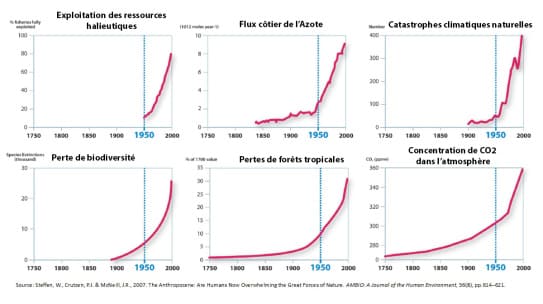Oui, et c’est le mot de ce siècle. Il désigne dorénavant notre époque. Celle de notre planète remodelée par les êtres humains. Naturellement, je n’avais rien inventé. Le mot a été prononcé et utilisé pour la première fois dix ans auparavant, en 1995, par un scientifique prix Nobel de chimie. Il était d’usage déjà assez répandu dans la presse de vulgarisation scientifique pour être parvenu jusqu’à moi. C’était donc juste un emprunt dont je dois dire que je ne me souvenais plus de l’origine. Il s’agit dorénavant d’un terme tout à fait officiel depuis le dernier trimestre 2016. Il a été validé par la communauté scientifique réunie dans le congrès de géologie internationale après quelques années d’examen. Il a donné lieu à quelques controverses instructives, qui ne sont pas épuisées depuis, je crois bien. Mon seul mérite aura été d’être le premier homme politique en France à utiliser ce mot et à en tirer des conclusions politiques.
Le mot et ce qu’il désigne.
L’Anthropocène ? Il s’agit d’un âge géologique spécifique de la vie de la planète succédant à bien d’autres. Il nous reste tous quelques lointains souvenirs scolaires de cette nomenclature. Le miocène, le pléistocène, et les grandes périodes telles que le tertiaire ou le quaternaire et ainsi de suite ne sont pas tout à fait des inconnus pour chacun d’entre nous. Les transitions entre ces périodes géologiques sont marquées par des changements nets que l’on doit pouvoir observer dans la stratigraphie de la Terre. Concrètement, cela signifie que les changements d’époque doivent pouvoir se constater en étudiant les dépôts de sédiments. Ceux-ci se font en strates comme on l’observe un peu partout où les couches profondes du sol affleurent.
C’est de cette façon que l’on a constaté et vérifié l’impact d’une météorite dans le golfe du Yucatan. Elle aurait provoqué, à la fin de la période nommée « crétacé », une extinction massive et même quasi-totale des espèces vivantes dont les malheureux dinosaures. Une très mince couche sur toute l’étendue du globe contient les sédiments incontestés de cette météorite. Elle atteste aussi la trace dramatique des évènements, que la nuit et le froid qui en ont résultés, ont ensuite provoqué dans toute la biosphère. À partir de là, toutes sortes de fossiles ordinaires disparaissent purement et simplement dans les couches géologiques suivantes.
De même, l’Anthropocène est l’âge où les activités de l’être humain modifient la composition physique de la planète. Oui, cette chétive créature, ce singe nu, est devenu la première force physique active de la nature. Charriant plus de gravats que tous les fleuves et vents du monde, changeant la composition physique de l’air davantage que n’importe quelle éruption volcanique, elle enclenche des réactions en chaîne qui se conjuguent l’une avec l’autre. Ainsi pour la composition de l’atmosphère et son contenu en gaz carbonique, comme pour la masse et la composition des mers et des océans. De là résultent toutes sortes d’événements climatiques qui impliquent tout ce qui vit, végétaux comme animaux. Ce qui a d’innombrables conséquences comme cette sixième extinction massive des espèces vivantes qui est en cours. Au demeurant l’anthropocène se manifeste aussi par des traces physiques humaines très spécifiques et tout à fait irréversibles. Pensons ici à certains matériaux apparaissant désormais partout dans la nature et qui ne s’y trouvaient pas auparavant. Par exemple le plastique. Ou bien les matières qui sont en action dans l’industrie nucléaire en général, essais militaires inclus.
Le terme anthropocène a été « inventé » par Paul Crutzen. C’est un chimiste hollandais déjà prix Nobel de chimie pour avoir expliqué l’effet destructeur de certains agents chimiques sur la couche d’ozone. Cette référence à la couche d’ozone et aux mesures prises avec succès pour empêcher sa destruction me permet d’enchainer sur une idée essentielle à mes yeux qui est la raison d’être de ce court chapitre additif. Il s’agit de la nécessité de politiser le terme et la réalité de l’anthropocène. Car sinon la tentation serait trop forte de ne voir que l’effet systémique purement physique de cette transition géologique. En gros, on ne verrait alors que le résultat aveuglé d’actions sans caractéristiques particulières. Ainsi quand on fait remonter le phénomène au début de l’agriculture en général. On peut y voir en effet le premier impact humain sur la biologie de la planète. On peut aussi remonter à la première utilisation systématique de combustibles carbonés pour dater le début du changement de la composition physique de l’atmosphère. On dit juste alors, sans aucun doute. Mais cela ne permet pas de comprendre l’accélération phénoménale du processus depuis moins d’un siècle et même depuis moins d’un demi-siècle pour certains aspects comme la destruction de la biodiversité.
Car c’est une chose que les Romains antiques n’aient pas eu conscience des conséquences de ce qu’ils déclenchaient en systématisant la consommation de certains combustibles dont la trace se retrouve dans les carottes glaciaires ; c’est une chose aussi que les conquistadors n’aient pas eu conscience des conséquences dans l’atmosphère du génocide dont ils furent responsables ; mais cet aveuglement ne saurait s’appliquer à l’époque actuelle. L’exemple de la lutte contre le trou dans la couche d’ozone en atteste. Le phénomène a été compris grâce aux travaux de Crutzen et cela permis d’intervenir à temps pour en inverser le processus en interdisant l’usage par l’industrie des aérosols des gaz incriminés. Cela suffit à montrer comment l’anthropocène, âge de l’impact de la civilisation humaine sur la nature de la planète est inscrit dans le domaine de la politique et de ses décisions.
L’ère du peuple dans l’anthropocène
Dans cette façon de voir, on constate alors le lien qui unit « l’ère du peuple » à l’anthropocène. Car l’accélération des phénomènes caractéristiques de l’anthropocène, jusqu’au point dramatique où ils se situent dorénavant, est très étroitement corrélée à l’explosion démographique de la communauté humaine. C’est aussi cette explosion qui fait naître « l’homo urbanus » en réseau, caractéristique politiquement de ce que j’ai appelé « l’ère du peuple ». C’est dans la période, après les années 50 du vingtième siècle, que se situe cette explosion. Elle suit le doublement de la population humaine de 1 à 2 milliards d’individus. À partir de là encore, le cycle d’augmentation de la population mondiale devient de plus en plus bref. De ce moment vient la montée en flèche de tous les processus caractéristiques de l’anthropocène en tant que phénomène modifiant radicalement les paramètres physiques de la planète. Et cela jusqu’au point où ils deviennent irréversiblement destructeurs pour l’écosystème compatible avec la vie humaine.

Mais cette explosion du nombre se réalise dans des rapports sociaux de production, d’échange et de consommation bien spécifiques eux aussi dans l’histoire de la civilisation humaine (quand on considère celle-ci comme un tout). Il s’agit de la période du mode de production basée sur la production sociale de masse et l’accumulation privée comme moteur spécifique de cette époque. Si bien que s’ajoute aux contradictions catastrophiques particulières de ce type de rapport sociaux de production une contradiction nouvelle majeure qui les englobe toutes. Il s’agit de la contradiction politique centrale de notre temps. Celle qui se constate entre le caractère infini des désirs et des besoins suggérés par l’économie de l’offre, qui est le moteur du capitalisme de notre époque, et le caractère limité des ressources qui permettraient d’y répondre. Cette contradiction est indiscutablement politique puisqu’elle correspond très directement à des choix économiques faits délibérément et en toute connaissance des effets induits. Cela ne signifie pas qu’il n’y ait pas d’effet systémique. Dit autrement, cela ne signifie pas que les acteurs dominants décident délibérément de la destruction de notre écosystème.
Bien sûr que même les plus bornés et les plus stupides ne le souhaitent pas, même quand ils sont obstinément « climatosceptiques » comme on le dit de ceux qui doutent de la cause humaine du dérèglement climatique actuel. Mais l’origine politique délibérée des décisions qui aboutissent à cet effet de système sont non moins incontestables. L’opposition entre des besoins et des désirs infinis, délibérément auto-entretenus par le modèle culturel dominant, confrontés à la réalité des moyens physique limités d’y pourvoir en est la conséquence directe. Elle est radicalement politique. Le mythe de la croissance infinie comme solution revendiquée en permanence par le discours néolibéral comme social-démocrate atteste de la faillite intellectuelle et pratique de cette façon d’envisager la suite de l’histoire de la civilisation humaine. Ce qui me semble décisif alors ce ne sont pas seulement les causes de cette situation mais le fait qu’elles échappent à tout contrôle collectif capable de les maîtriser.
C’est pourquoi le caractère de la révolution à opérer est avant toute chose politique au sens littéral. C’est-à-dire qu’elle concerne la capacité existante ou non à décider et d’appliquer ce qui est bon pour tous, au sens de l’intérêt général humain. Cela et non pas seulement ce qui est bon et efficace du point de vue d’une finalité plus étroite comme celle d’un intérêt particulier, si légitime soit-il dans son domaine. C’est une des raisons pour lesquelles je dis de la révolution politique appelée par L’Ère du peuple qu’elle est « citoyenne ». C’est-à-dire qu’elle consiste dans la récupération des moyens politiques de décisions davantage que n’importe quel aspect lié à cet objectif, comme le caractère de la propriété des moyens de production. En cela, cette thèse n’annule pas les raisonnements politiques du passé mais elle les inclue dans une dimension qui les englobe et en reformule le mode d’emploi.
Anthropocene is the key word of this century
The word « anthropocene », which was already used in the original version of the book L’Ere du Peuple (the Era of the People) published in 2014, is now commonly used in the public debate. For Jean-Luc Mélenchon, it is the key word of this century.
This text was first posted on Jean-Luc Mélenchon’s blog.
Yes, it is indeed the key word of this century. It refers to our era, that of human beings remodeling the planet. Of course, the word was none of my inventions : it was first coined twenty years before the book was published by a scientist who received the Nobel Prize in chemistry in 1995. By 2014, it was already common enough in the popular scientific press to reach me. Therefore, I merely borrowed it, oblivious then to where I had come across it. It has now been made official since the last term of 2016. After being considered for a few years, it has been accepted by the scientific community attending the International Geological Congress. It has brought about a few interesting controversies which haven’t yet come to an end since, I believe. My only merit is to be the first French politician to use the word, and to draw political conclusions from it.
The word and what it refers to.
But what is the Anthropocene ? It is a specific geological age of the life of our planet following many others. We all have some distant school memories of this classification. The Miocene, the Pleistocene and the great periods such as the tertiary and the quarternary eras, and so on, sound somehow familiar to us. The transitions from one geological period to another are characterized by abrupt changes that are observable in the stratigraphy (the study of the successive layers) of the Earth. In concrete terms, it means that the shifts from one era to another can be observed by studying the sediment deposition. Sediments settle in layers, as can be observed in many places where the deep layers of the ground show.
Thus the impact of a meteorite could be observed and confirmed in the Yucatan peninsula. At the end of the epoch called « Cretaceous », it supposedly brought about a mass extinction, destroying almost all the living species, among which the dinosaurs. A very thin layer which spread over the surface of the whole planet undeniably contains sediments from this meteorite. It also bears witness to the dramatic events which took place in the whole of the biosphere, induced by the night and cold it triggered. From that moment, all kinds of common fossiles altogether disappeared into the geological layers that were to come.
Similarly, the Anthropocene is the age when the activities of human beings alter the natural composition of the planet. Indeed, this weak creature, this naked ape, has become the most important active physical force of nature. Carrying along more rubbles than any river or wind, altering the composition of the air more than any volcanic eruption, these changes trigger cumulative chain reactions. Thus it impacted the composition of the atmosphere and its content in carbon dioxide as well as for the mass and composition of seas and oceans. As a result, it gives rise to many climate events implying all that is alive – plants or animals – which has multiple consequences, like this sixth mass extinction of living species currently in progress. Moreover, the Anthropocene is also perceptible through very specific and quite irreversible concrete human traces. We may mention some materials now visible everywhere in nature, which didn’t used to be there – plastic, for instance – or the matter used in the nuclear industry in general, including military tests.
The word « Anthropocene » itself was coined by Paul Crutzen, a Dutch chemist, who was awarded the Nobel Prize in chemistry for accounting for the destructive effect of some chemical elements on the ozone layer. This mention of the ozone layer and the measures successfully taken in order to prevent its destruction enables me to move on to an idea that I find essential, which is the reason for this short additional essay. It lies in the fact that we have no choice but to make the word and the reality of the Anthropocene, political. If we don’t, it would be too tempting to see only the systemic and purely concrete effect of this geological transition. Roughly, it would be like wearing blinkers so as to focus on the mere result of actions, without considering the whys and wherefores of this result. It is so when we consider the phenomenon started in the early stages of agriculture in general. Indeed, there can we find the first impact exerted by humans on the biology of the planet. We might as well decide it started when carbon fuels were first used on a systematic basis, which marked the beginning of the change of the composition of the atmosphere. No doubt this is right. But it does not enable us to understand the tremendous acceleration of the process over the last century or so, even over the last fifty years or so regarding aspects such as the destruction of biodiversity.
For if it is understandable that the Romans in the Antiquity were not aware of the consequences of the changes they triggered by making the use of some fuels systematic – the traces of which can still be found in the ice caps -, or that the conquistadors were not aware of the consequences of the genocide they were responsible for, it is no longer so. The example set by the actions taken to address the hole in the ozone layer proves it. The phenomenon could be understood thanks to Crutzen’s studies, which enabled us to act in time and reverse the process by banning the use of the harmful gas sprays in the industrial sector. This is enough to show to what extent the Anthropocene, this age of impact of human civilisation on the environment of this planet, is a political issue, and concerns political decisions.
The Era of the Poeple in the Anthropocene
Consequently, it is easy to understand the link between « the Era of the People » and the Anthropocene. Indeed, the acceleration of the phenomena characterizing the Anthropocene up to the dramatic phase they have led us to, is closely linked to the human demographic explosion. It is this very explosion that led to the birth of « Homo Urbanus », who relies on networks to live and is a political feature of what I have called « the Era of the People ». This explosion started after the 1950s, following the doubling of human population from 1 to 2 billion people. From that moment onward, the cycle of world population growth has become shorter and shorter. From then on, all the processes that characterize the Anthropocene – as a phenomenon that utterly alters the physical parameters of the planet – have soared to the point when they have become irreversibly destructive to an ecosystem compatible with human life.
But this demographic explosion also finds its way in the social intercourse of production, exchanges and consumption, which are themselves very specific at this point in the history of human civilisation – if we take this history as a whole. It is a period when the mode of production is based on social mass production and private capital accumulation – both constituting the specific economic engine of the period. As as resut, a new major contradiction arises, in addition to the already disastrous contradictions of this particular type of social intercourse in the production sector. This new contradiction is at the core of our period, it is political in nature and encompasses them all. It lies between the infinity of our desires, the needs inspired by an economic model encouraging supply, at the core of contemporary capitalism, on the one hand, and the limitation of the resources which would make it possible to meet demand on the other hand. This contradiction is undeniably political, since it is a consequence of the economic choices made deliberately and in full knowledge of the induced effects. It does not mean there is no systemic effect. In other words, it does not mean that leading figures deliberately decide our ecosystem will be destroyed.
And indeed, even the most stubborn and the most stupid of them do not, even when they are stubbornly « climate skeptical », calling into question human liability and responsibility in on-going climate change process. But the deliberate political origin of the decisions leading to this systemic effect is nonetheless indisputable. Its direct consequence is the opposition between our needs and infinite desires, which are deliberately fueled by the leading cultural model, and the reality of limited concrete means to fulfill them. It is radically political. The myth of infinite growth as a solution constantly advocated by neoliberals as well as social-democrats is a proof of the intellectual and practical collapse induced by this way of considering what is to come in the course of human history. What seems to me of the utmost importance here is not the causes of this situation but the fact that these causes cannot be collectively controled and therefore cannot be mastered.
That’s why the nature of the revolution that has to be led is first and foremost political in the literal sense. It means it is about being able or not decide and implement what is good for everyone, from the viewpoint of general human interest. This is what matters, and not what is good and efficient from the viewpoint of a more narrow goal to reach, such as a specific interest, however legitimate it may be within its own realm. That’s one of the reasons why I say of the political revolution called for by the Era of the People, that it is a « citizens’ » revolution, which means that it consists in getting back political decision-making power more than any other thing related to this goal – for instance, who owns the means of production, and how. In this regard, this theory does not invalidate the political arguments of the past but it encompasses them all within a dimension which modifies how they should be understood and used.



